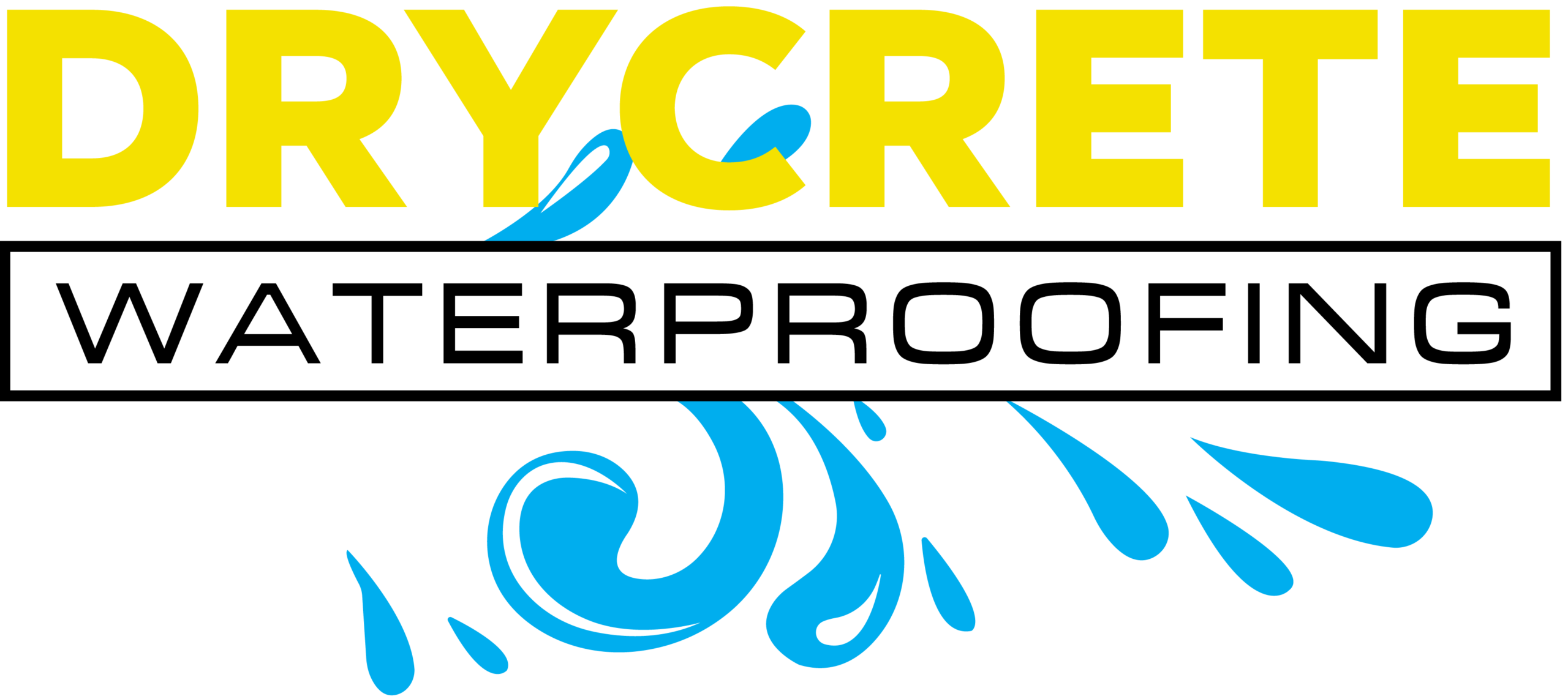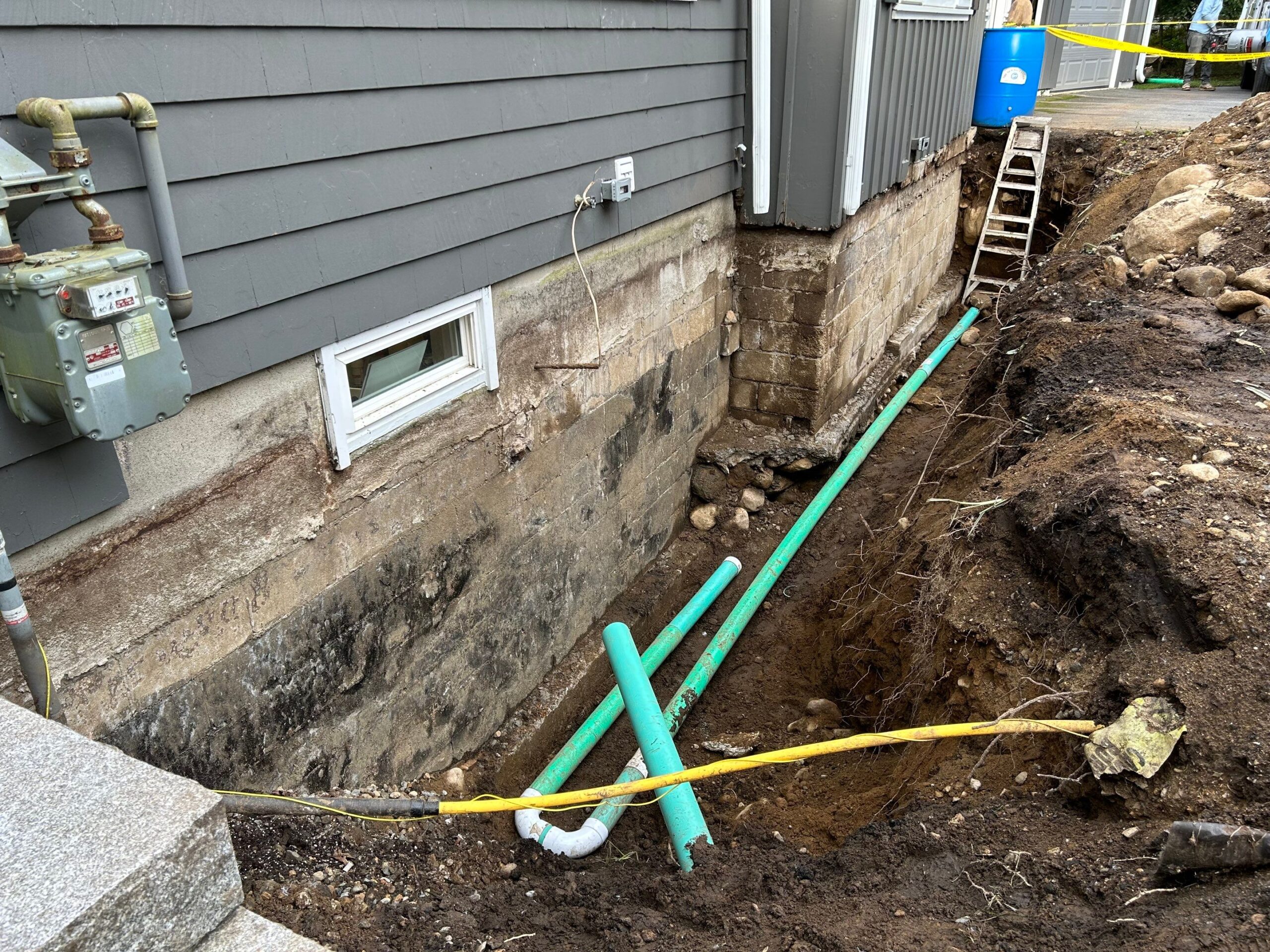When it comes to keeping your basement nice and dry, there’s a baffling range of options out there. From sump pumps to crystalline solutions, it can be tricky for the homeowner to know what their options are. Today we’re going to take a deep dive (excuse the pun) into what a footing drain, also known as foundation drain, is.
What are Footing Drains
There are a few different things that go by the title ‘Footing Drain’, but in the context we’re talking about, they’re effectively exterior French drains which are installed against the exterior of your basement wall, alongside the footing. Hence the name.
They consist of three elements.
- A perforated pipe
- Gravel
- A Fabric Filter
The perforated pipe is placed up against your basement footing, surrounded by gravel and wrapped in a filter fabric. The gravel holds the pipe and acts as a additional filter, preventing material from entering through the perforations.
Water always follows the path of least resistance and, foundation drains ensure that’s away from your basement walls and floor. This is the real secret to waterproofing: you can’t really stop water, just move it along. Getting this right can prevent all kinds of problems, including mold, cosmetic damage and even structural failure in extreme cases.
When water hits the wall of your home, it travels downwards towards the gravel bed, where it’s conducted harmlessly away. Thanks to being placed so low down footing drains can also be useful in the case of rising groundwater too.
They’re effective at stopping water from accumulating against the exterior of your basement walls. They’re generally installed during construction, but you might consider having one put in if you’re doing other exterior work. That being said, they’re perhaps not the best option in most cases.
Installing Footing Drains
Installing a footing drain is a fairly straightforward process, even if it can be a bit messy and disruptive. For these reasons, they’re usually installed during construction and only very rarely (if ever) as a later addition to your home.
A trench is dug alongside your basement wall, right down to the level of your floor slab. The pipe is pushed up against the wall, the filter installed over it and the trench is filled with gravel. There’s nothing particularly tricky about it, but as with any landscaping work, it does tend to make a bit of a mess while it’s being carried out.
The idea is that the gravel will filter out larger bits of debris and the fabric (if installed) will catch the smaller bits. In practice, this usually works for a while before things find their way through. Once this happens, the system starts to loose effectiveness until eventually, it clogs.
When installed as part of a construction project, it’s a straightforward way to add a layer of protection, albeit one with some downsides to consider.
Ongoing Maintenance
Footing drains require a good deal of regular maintenance to keep them working properly.
They have a tendency to get “gummed up” with debris- bits of soil, stray leaves and general garden gunk. The gravel bed and filter fabric are meant to stop this finding its way inside, but that doesn’t always prove true.
Eventually, things will find their way between the stones and clog up the filter. From there, it’s only a matter of time before your drain becomes a problem rather than a solution. Keeping up with general cleaning and maintenance will slow the process, but it’s a losing battle. Eventually, something will block your footing drain.
Keeping the top layer of gravel clear is pretty easy- simply pick up any debris that you find. Clearing the filter is more of a task- you’ll have to be able to get at it to do it. This will involve moving the gravel out of the way and that can be pretty laborious. Eventually, this will need doing as the surrounding soils are washed through the gravel sieve.
On the occasions that something does find its way through the gravel and filters, you’ll need to snake them out. There should be a vent somewhere along the line of your footing drain to allow access but it’s not always easy to find. Once you’ve located this access point, you’ll need a snake or a drain hose long enough to reach and clear the obstruction.
Effectiveness of Footing Drains
While they’re working properly, foundation drains are undoubtedly effective. They conduct standing water away from your vulnerable walls, ensuring it doesn’t find a way in. When it comes to waterproofing, moving water away really is the name of the game.
That being said, when compared to more modern methods, they’re often not the best solution. Let’s break it down:
Between the two main options for this job, foundation drains have a few bonuses:
When installed during construction, footing drains are really straightforward and it usually makes sense to install them.
- They’re cheap,
- Easy to fit
- Don’t get in the way
- They’re located fully underground, so they don’t tend to stand out.
On the other hand they certainly have their downsides too:
- They have a habit of clogging
- They’re hard to fix if they break
- They’re hard to install after construction
- They require a drainage point lower than your home
Interior French Drains
When it comes to moving standing water away from your basement walls, the main competitor to the footing drain is the French drain.
Like their counterparts, they consist of a perforated pipe which allows water in, set in a bed of gravel. Where they stand out is in how much more flexible they are. They can be installed either internally or externally, depending on where your problems are, but we’ll focus on interior versions:
- Installed higher up around your home- at the level of your basement floor.
- Installation can be carried out at any time with a minimum of disruption.
- No exterior excavation required, saving disruption and costs
- Easy to access, making maintenance easier
- More effective against interior problems such as rising groundwater or heavy rain.
Head To Head Comparison
When contrasted like this, it’s easy to see why many home builders install a footing drain during construction. They work reasonably well, cost very little and take next to no effort to install.
It’s also easy to see why they’re a nice thing to have, but their problems and limitations are equally pretty clear.
Eventually, they will go wrong, as all things do. Their advantages quickly dry up (excuse the pun) when you’re faced with the cost of clearing and repairing them.
French drains on the other hand, mitigate many of these issues through simply being easier to access and maintain. While they might not deal with exterior issues, they can seriously help with the effects of a failed footing drain. The reverse can’t really be said.
Do Footing Drains Work
The short answer is; yes, they do work. The long answer is; yes, they do work pretty well, but there are some pretty serious caveats.
When the filters and gravel work and no blockages occur, they’re great at dealing with the threat of water intrusion. However, over time, they’re bound to get jammed up with debris and you’ll see a slow decline in their efficiency. As the debris builds up, it will eventually find its way into the pipe and cause a blockage. This then means the drain isn’t doing its job and might actually be holding water against your home. Rectifying this problem can be costly, time consuming and disruptive.
The better question is “are they effective vs my other options” and then the answer gets a bit more complex.
When compared to an interior French drain, the effectiveness of foundation drains is cast in a rather different light. Then we see them as they really are: hard to maintain, disruptive to fix and limited in their usages.
They absolutely have their place, but footing drains are not the comprehensive solution to your basement waterproofing needs.
If you’re considering building a new house, it’s still standard practice to install a footing drain when suitable to the project. If you’re carrying out remedial works, they’re rarely worth the hassle and your focus should be on other techniques.

